What Is The Best Dry Food For Cats? The answer lies in understanding your cat’s unique needs and the nutritional landscape of available options. FOODS.EDU.VN is here to help you navigate the world of feline nutrition. Providing you with expert-backed advice and top-rated recommendations. Consider factors like protein quality, carbohydrate content, and the inclusion of beneficial additives.
Discovering the most suitable dry cat food involves examining elements such as nutritional composition, ingredient quality, and digestibility. Let FOODS.EDU.VN guide you through selecting the ideal choice for your feline friend. You’ll gain insights on vital nutrients and avoiding detrimental components, promoting your cat’s health and vitality.
1. Understanding Your Cat’s Nutritional Needs
1.1. The Carnivore Diet: What Cats Need
Cats are obligate carnivores, meaning their bodies are designed to thrive on a diet primarily composed of animal protein. This isn’t just a preference, it’s a biological imperative. According to the Journal of Animal Physiology and Animal Nutrition, cats require specific amino acids found in animal tissues to maintain optimal health.
These essential nutrients include:
- Taurine: Vital for heart function, vision, and reproduction. Deficiencies can lead to serious health issues.
- Arginine: Necessary for removing ammonia from the body. A lack of arginine can be life-threatening.
- Carnitine: Important for fat metabolism and energy production.
Dry cat food must be carefully formulated to meet these unique dietary requirements. Opting for formulas rich in animal-derived proteins ensures your cat receives the vital nutrients needed for a healthy and active life.
1.2. The Role of Protein, Fat, and Carbohydrates
A balanced diet for cats should prioritize protein and fat while limiting carbohydrates. Here’s a breakdown:
- Protein (30-40%): Supports muscle development, immune function, and overall health.
- Fat (15-30%): Provides energy, supports hormone production, and aids in the absorption of fat-soluble vitamins.
- Carbohydrates (less than 10%): Cats have limited ability to digest and utilize carbohydrates efficiently. High levels can lead to obesity and other health issues.
Dry cat foods often contain higher levels of carbohydrates than wet food due to the need for binding agents. Carefully selecting brands with lower carbohydrate content and higher protein and fat levels is essential.
1.3. The Importance of Hydration
Cats have a low thirst drive and often don’t drink enough water, which can lead to dehydration and urinary problems. Dry food, with its low moisture content, exacerbates this issue.
The American Animal Hospital Association recommends ensuring adequate water intake for cats, especially those on a dry food diet.
Here are some strategies to increase your cat’s hydration:
- Provide fresh water: Ensure clean, fresh water is always available.
- Use water fountains: Many cats prefer drinking from moving water sources.
- Supplement with wet food: Adding wet food to your cat’s diet significantly increases their moisture intake.
- Add water or broth to dry food: Softening the dry kibble with water or low-sodium broth can make it more appealing and hydrating.
2. Decoding Dry Cat Food Labels
2.1. Understanding Guaranteed Analysis
The Guaranteed Analysis (GA) on a cat food label provides minimum or maximum percentages of key nutrients. Understanding how to interpret this information is crucial for selecting a healthy food.
Here’s what to look for:
- Crude Protein: The minimum percentage of protein.
- Crude Fat: The minimum percentage of fat.
- Crude Fiber: The maximum percentage of fiber.
- Moisture: The maximum percentage of moisture.
However, the GA doesn’t tell the whole story. It’s essential to consider the Dry Matter Basis (DMB) to get a more accurate picture of the nutrient content.
2.2. Calculating Dry Matter Basis (DMB)
DMB removes the moisture content to provide a standardized comparison of nutrient levels across different foods.
Here’s how to calculate DMB:
- Calculate Dry Matter (DM): 100% – % Moisture = % DM
- Calculate DMB for each nutrient: (% Nutrient / % DM) x 100 = % Nutrient on DMB
Example:
A dry food has:
- Crude Protein: 34%
- Moisture: 8%
- DM: 100% – 8% = 92%
- Protein on DMB: (34% / 92%) x 100 = 36.96%
This calculation allows for a more accurate comparison of the actual nutrient content of different foods, regardless of their moisture levels.
2.3. Ingredient Lists: What to Look For and Avoid
The ingredient list is organized in descending order by weight. The first few ingredients make up the bulk of the food, so pay close attention to them.
Ingredients to Look For:
- Named meat sources: Chicken, turkey, salmon, etc.
- Meat meals: Concentrated protein source (e.g., chicken meal, fish meal).
- Animal fats: Chicken fat, fish oil (good sources of essential fatty acids).
- Essential vitamins and minerals: Taurine, Vitamin E, Vitamin D, etc.
Ingredients to Avoid:
- Unnamed meat sources: “Meat by-products,” “animal digest” (vague and potentially low-quality).
- Excessive fillers: Corn, wheat, soy (poorly digested and can cause allergies).
- Artificial additives: Colors, flavors, preservatives (can be harmful).
- High levels of plant-based proteins: Peas, lentils, chickpeas (cats are carnivores and need animal protein).
2.4 Understanding AAFCO Statements
The Association of American Feed Control Officials (AAFCO) regulates pet food in the United States. Look for an AAFCO statement that confirms the food is “complete and balanced” for your cat’s life stage (kitten, adult, or all life stages). This statement ensures the food meets minimum nutritional requirements established by AAFCO.
3. The Best Dry Cat Food Ingredients: A Deeper Dive
3.1. High-Quality Protein Sources
The best dry cat foods prioritize high-quality animal protein sources. These include:
- Chicken: A common and easily digestible protein source.
- Turkey: A lean and palatable alternative to chicken.
- Fish: Salmon, whitefish, and herring provide essential omega-3 fatty acids.
- Beef: A rich and flavorful protein source (suitable for cats without sensitivities).
- Lamb: A novel protein option for cats with allergies.
Meat meals are also acceptable, as they are a concentrated source of protein. However, ensure they are made from named meat sources (e.g., chicken meal, not “poultry meal”).
3.2. Beneficial Fats and Oils
Healthy fats are crucial for energy, skin and coat health, and the absorption of fat-soluble vitamins. Look for these beneficial fats and oils:
- Chicken fat: A good source of linoleic acid (an essential omega-6 fatty acid).
- Fish oil: Rich in omega-3 fatty acids (EPA and DHA), which have anti-inflammatory properties.
- Coconut oil: Provides medium-chain triglycerides (MCTs), which can be easily digested and used for energy.
Avoid foods with excessive amounts of plant-based oils, such as soybean oil or corn oil, as they are less beneficial for cats.
3.3. Essential Vitamins and Minerals
A complete and balanced dry cat food should contain essential vitamins and minerals to support overall health. These include:
- Taurine: Crucial for heart and eye health.
- Vitamin A: Important for vision, immune function, and skin health.
- Vitamin D: Necessary for calcium absorption and bone health.
- Vitamin E: An antioxidant that protects cells from damage.
- B Vitamins: Support energy metabolism and nerve function.
- Zinc: Important for immune function and skin health.
- Iron: Necessary for red blood cell production.
3.4. The Role of Probiotics and Prebiotics
Probiotics and prebiotics can promote gut health and improve digestion.
- Probiotics: Beneficial bacteria that support a healthy gut microbiome (e.g., Lactobacillus, Bifidobacterium).
- Prebiotics: Non-digestible fibers that feed beneficial bacteria in the gut (e.g., chicory root, inulin).
Including these ingredients in dry cat food can improve nutrient absorption, reduce digestive issues, and support a healthy immune system.
4. Common Dry Cat Food Controversies
4.1. Grain-Free vs. Grain-Inclusive Diets
Grain-free diets have become popular, but are they necessary for all cats? While some cats may have sensitivities to grains, many can digest them without issue.
The American Veterinary Medical Association notes that grain-free diets are not inherently superior to grain-inclusive diets for most cats.
If your cat doesn’t have a diagnosed grain allergy, there’s no need to avoid grains. Whole grains like brown rice and oats can provide fiber and other nutrients. However, avoid foods with excessive amounts of grains or refined grains like corn and wheat.
4.2. The Truth About Fillers: Corn, Wheat, and Soy
Fillers are ingredients that provide little nutritional value and are often used to bulk up cat food. Corn, wheat, and soy are common examples.
While these ingredients are not necessarily toxic, they are poorly digested by cats and can contribute to allergies and digestive issues. Look for foods with limited or no fillers and prioritize those with high-quality protein and fat sources.
4.3. Artificial Additives: Colors, Flavors, and Preservatives
Artificial additives can be harmful to cats and should be avoided.
- Artificial colors: Provide no nutritional value and may cause allergic reactions.
- Artificial flavors: Can mask low-quality ingredients and may contain harmful chemicals.
- Artificial preservatives: BHA, BHT, and ethoxyquin have been linked to health problems.
Choose natural dry cat foods that use natural preservatives like Vitamin E (mixed tocopherols) and Rosemary Extract.
5. Top 10 Best Dry Cat Foods on the Market
Note: All recommendations are based on ingredient quality, nutritional value, and safety records. Consult with your veterinarian before making significant changes to your cat’s diet.
5.1. Overall Best: Open Farm RawMix Open Prairie Recipe
- Key Features:
- Humanely and sustainably sourced ingredients.
- High in animal-derived protein from chicken, turkey, and fish.
- Enhanced flavor with freeze-dried raw organ meats.
- Pros:
- Excellent ingredient quality and transparency.
- Palatable and well-received by cats.
- Cons:
- Higher in carbohydrates than some other options.
- Pricier than many dry foods.
5.2. Runner Up: FirstMate Chicken Meal with Blueberries Formula
- Key Features:
- Limited ingredient formula.
- Single source of animal protein (chicken meal).
- Free from artificial additives.
- Pros:
- Good for cats with sensitivities.
- Digestible and reduces reactivity.
- Cons:
- Fairly high dry matter carb content.
5.3. Best for Sensitive Stomach: Open Farm Harvest Chicken Freeze-Dried Cat Food
- Key Features:
- Single animal protein source (chicken).
- Contains muscle meat, organ meat, and ground bone.
- Omega-3 fatty acids from salmon oil.
- Pros:
- Carnivore-appropriate nutrition.
- Good for cats with sensitive stomachs.
- Cons:
- Low moisture content (requires rehydration).
- More expensive than average cat food.
5.4. Best For Picky Cats: Farmina Natural & Delicious Chicken & Ancestral Low-Grain Formula Dry Cat Food
- Key Features:
- Low-grain formula with spelt and oats.
- Multiple sources of animal protein.
- Contains herring oil and chicken fat.
- Pros:
- Palatable and nutritious.
- Low-glycemic formula.
- Cons:
- Contains some legumes.
- No kibble provides the moisture your cat needs.
5.5. Best Budget: Kirkland Signature Chicken and Rice Cat Food
- Key Features:
- Chicken and chicken meal as primary ingredients.
- Contains supplemental probiotics and prebiotics.
- Affordable option.
- Pros:
- Economical and accessible.
- Contains beneficial nutraceuticals.
- Cons:
- Not a low-carbohydrate food.
5.6. Best Air-Dried: ZIWI Peak Air-Dried Mackerel & Lamb Recipe Cat Food
- Key Features:
- Air-dried to preserve nutrients.
- 96% fresh meat, organs, bones, and mussels.
- Virtually zero carbohydrate content.
- Pros:
- Species-appropriate and nutrient-dense.
- Highly digestible.
- Cons:
- Expensive.
- Lower moisture content, add moisture for best results.
5.7. Best For Kittens: Tiki Cat Born Carnivore Deboned Chicken & Egg Recipe
- Key Features:
- Formulated specifically for kittens.
- High levels of protein and DHA.
- Meat-based recipe.
- Pros:
- Supports kitten growth and development.
- Rich in animal protein.
- Cons:
- Fairly high in carbohydrates.
- Contains some peas and legumes.
5.8. Best Low Carb: Dr. Elsey’s cleanprotein Chicken Formula Grain-Free Dry Cat Food
- Key Features:
- Very low carbohydrate content.
- High in animal protein.
- Grain-free formula.
- Pros:
- Nutrient-dense and easy to digest.
- Suitable for cats with diabetes or carbohydrate sensitivities.
- Cons:
- Expensive.
- Formula changes may affect palatability for some cats.
5.9. Best Chicken-Free: Orijen Six Fish Grain-Free Dry Cat Food
- Key Features:
- Completely free from chicken products.
- Made with 90% animal ingredients.
- Rich in omega-3 fatty acids.
- Pros:
- Good for cats with chicken allergies.
- High in animal protein.
- Cons:
- Beans and legumes may be hard for some cats to digest.
5.10. Premium Pick: Open Farm Chicken & Salmon Freeze Dried Raw Morsels for Cats
- Key Features:
- Freeze-dried raw formula.
- 98% humanely raised chicken and wild-caught salmon.
- Contains muscle meat, organs, and ground bone.
- Pros:
- Highly palatable and nutritious.
- Excellent for picky eaters.
- Cons:
- Low moisture content (requires rehydration).
- Raw food tends to be pricey.
Comparison Table:
| Product Name | Primary Protein | Guaranteed Protein | Calories Per Ounce | Cost Per Day |
|---|---|---|---|---|
| Open Farm RawMix Open Prairie Recipe | Chicken | 38% | 106 | $0.90 |
| FirstMate Chicken Meal with Blueberries Formula | Chicken | 36% | 100 | $0.76 |
| Open Farm Harvest Chicken Freeze-Dried Cat Food | Chicken | 47% | 149 | $3.75 |
| Farmina Natural & Delicious Chicken & Ancestral Low-Grain Formula Dry Cat Food | Chicken | 36% | 1174 | $1.16 |
| Kirkland Signature Chicken and Rice Cat Food | Chicken | 30% | 115 | $0.17 |
| ZIWI Peak Air-Dried Mackerel & Lamb Recipe Cat Food | Mackerel | 44% | 128 | $3.31 |
| Tiki Cat Born Carnivore Deboned Chicken & Egg Recipe | Chicken | 42% | 111 | $0.88 |
| Dr. Elsey’s cleanprotein Chicken Formula Grain-Free Dry Cat Food | Chicken | 59% | 113 | $0.85 |
| Orijen Six Fish Grain-Free Dry Cat Food | Herring | 40% | 118 | $0.75 |
| Open Farm Chicken & Salmon Freeze Dried Raw Morsels for Cats | Chicken, Salmon | 47% | 144 | $4.00 |
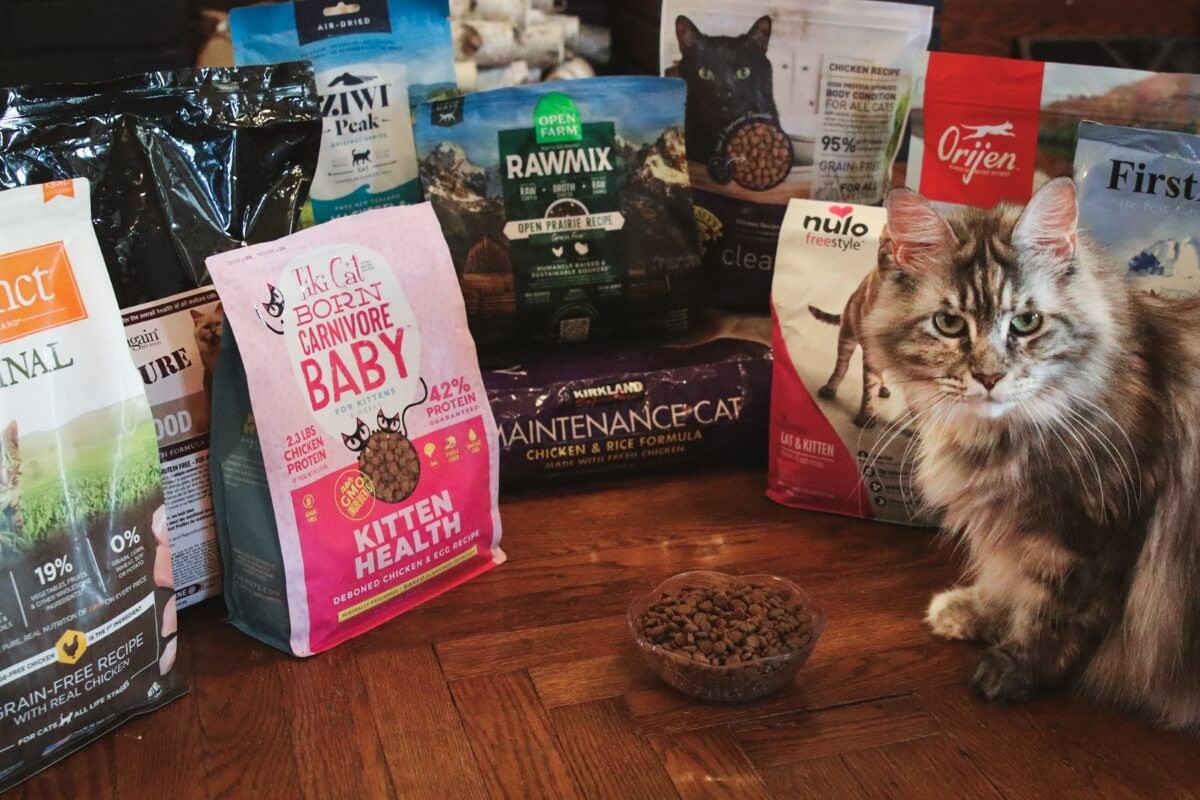
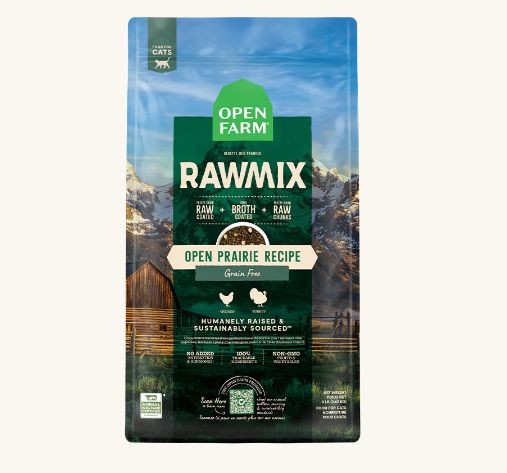
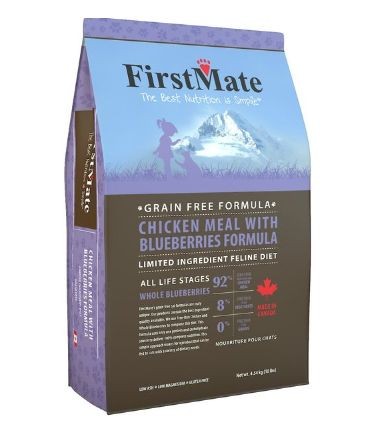
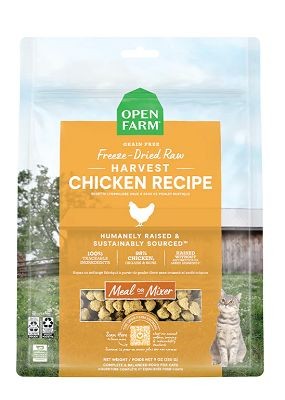
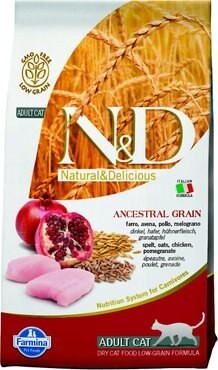
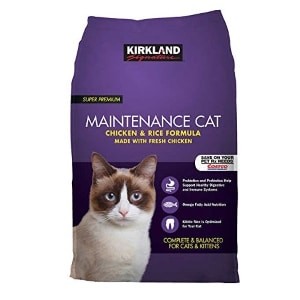
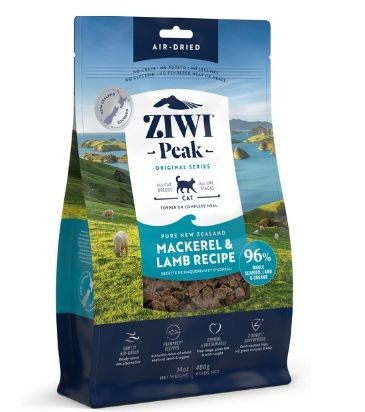
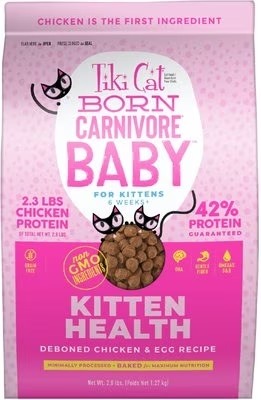
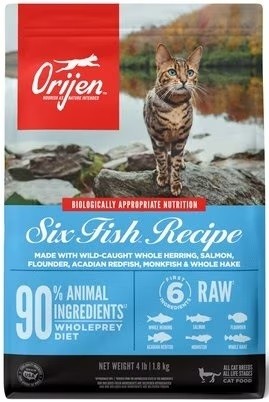
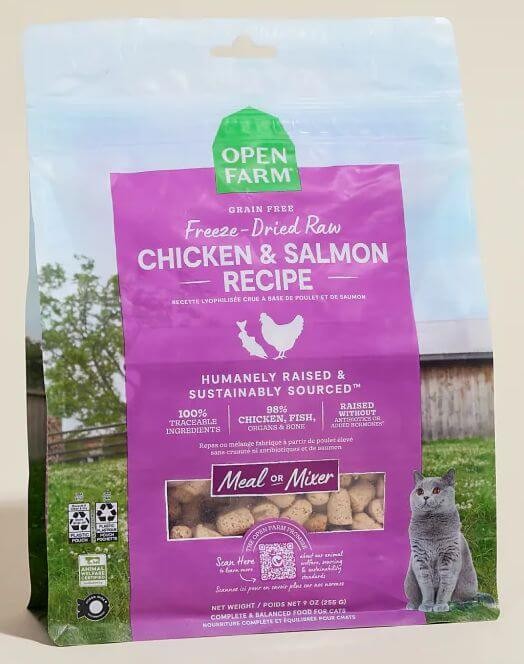
*Cost per day is calculated using the food’s average cost per ounce and the daily caloric requirement for a healthy adult cat (about 200 calories).
6. Transitioning Your Cat to a New Dry Food
6.1. The Gradual Approach
Abruptly changing your cat’s food can lead to digestive upset. A gradual transition over 7-10 days is recommended.
Here’s a sample transition schedule:
- Days 1-3: Mix 25% new food with 75% old food.
- Days 4-6: Mix 50% new food with 50% old food.
- Days 7-9: Mix 75% new food with 25% old food.
- Day 10: 100% new food.
Monitor your cat’s stool and appetite during the transition. If you notice any digestive issues (diarrhea, vomiting, or loss of appetite), slow down the transition or consult with your veterinarian.
6.2. Tips for Picky Eaters
Some cats are more resistant to change than others. Here are some tips for transitioning picky eaters:
- Mix wet and dry food: Adding a small amount of wet food to the new dry food can make it more appealing.
- Warm the food: Heating the food slightly can enhance its aroma and make it more enticing.
- Use food toppers: Sprinkle a small amount of a palatable food topper (e.g., freeze-dried meat) on top of the new food.
- Be patient: It may take time for your cat to accept the new food. Don’t give up easily.
6.3. When to Consult Your Veterinarian
Consult with your veterinarian before making significant changes to your cat’s diet, especially if your cat has any health issues. Your veterinarian can provide personalized recommendations based on your cat’s specific needs.
7. Addressing Common Concerns
7.1. Dry Food and Urinary Health
Dry food’s low moisture content can contribute to urinary problems in cats. To mitigate this risk:
- Increase water intake: Provide fresh water, use water fountains, and consider adding wet food to your cat’s diet.
- Choose a urinary health formula: Some dry cat foods are formulated to support urinary health by controlling mineral levels and pH.
- Monitor your cat’s urine: Watch for signs of urinary issues (straining to urinate, blood in urine, frequent urination) and consult with your veterinarian if you notice any problems.
7.2. Dry Food and Weight Management
Dry food’s calorie density can contribute to weight gain. To manage your cat’s weight:
- Measure food portions: Use a measuring cup to ensure you’re feeding the correct amount.
- Choose a weight management formula: Some dry cat foods are formulated to be lower in calories and higher in fiber.
- Increase activity: Provide opportunities for exercise and play.
- Monitor your cat’s weight: Weigh your cat regularly and adjust food portions as needed.
7.3. Dry Food and Dental Health
Some dry cat foods are marketed as beneficial for dental health. While dry kibble can help scrape plaque off teeth, it’s not a substitute for professional dental care.
- Choose a dental health formula: Look for kibble that is specifically designed to promote dental health.
- Brush your cat’s teeth: Regular tooth brushing is the best way to maintain your cat’s dental health.
- Schedule regular dental cleanings: Professional dental cleanings are necessary to remove tartar and prevent dental disease.
8. Dry Cat Food: Storage and Handling
8.1. Proper Storage Techniques
Proper storage is essential to maintain the quality and safety of dry cat food.
- Keep food in a cool, dry place: Avoid storing food in direct sunlight or humid environments.
- Use an airtight container: Transfer food from the bag to an airtight container to prevent spoilage.
- Don’t mix old and new food: Completely empty and clean the container before adding new food.
8.2. Shelf Life and Expiration Dates
Pay attention to the expiration date on the bag. Dry cat food typically has a shelf life of 12-18 months. Once opened, it should be used within 4-6 weeks.
8.3. Preventing Contamination
To prevent contamination:
- Wash your hands: Wash your hands before and after handling cat food.
- Clean food bowls regularly: Wash food bowls daily with soap and water.
- Store food away from pests: Keep food in a sealed container to prevent pests from accessing it.
9. Frequently Asked Questions (FAQ)
- Is dry food bad for cats? Dry food is not inherently bad, but it should be high-quality, protein-rich, and low in carbohydrates. Supplement with wet food and ensure adequate hydration.
- Can dry food be the only food source for my cat? While possible, it’s best to supplement with wet food to increase moisture intake and provide a more balanced diet.
- How much dry food should I feed my cat? Follow the feeding guidelines on the food label, but adjust as needed based on your cat’s weight, activity level, and overall health.
- What are the best dry food brands for cats? Open Farm, FirstMate, Tiki Cat, and Dr. Elsey’s are among the top-rated brands for dry cat food.
- How can I tell if my cat is allergic to their food? Symptoms of food allergies include itching, skin problems, vomiting, and diarrhea. Consult with your veterinarian if you suspect a food allergy.
- Is grain-free food better for cats? Not necessarily. Grain-free diets are not inherently superior to grain-inclusive diets for most cats.
- What are the best ingredients to look for in dry cat food? Named meat sources, meat meals, animal fats, and essential vitamins and minerals.
- What ingredients should I avoid in dry cat food? Unnamed meat sources, excessive fillers, artificial additives, and high levels of plant-based proteins.
- How do I transition my cat to a new dry food? Gradually mix the new food with the old food over 7-10 days.
- Can dry food help clean my cat’s teeth? Some dry cat foods are designed to promote dental health, but they are not a substitute for regular tooth brushing and professional dental cleanings.
10. FOODS.EDU.VN: Your Partner in Feline Nutrition
Choosing the best dry food for your cat can feel overwhelming. FOODS.EDU.VN is here to simplify the process with expert-backed advice, comprehensive guides, and top-rated recommendations.
We understand the challenges of finding reliable information and navigating the complexities of pet food labels. That’s why we’re committed to providing you with accurate, unbiased, and easy-to-understand resources.
Discover More on FOODS.EDU.VN
- In-depth articles: Explore our library of articles on cat nutrition, health, and wellness.
- Product reviews: Read our unbiased reviews of top-rated dry cat foods.
- Expert advice: Get personalized recommendations from our team of veterinary advisors.
- Community forum: Connect with other cat owners and share your experiences.
At FOODS.EDU.VN, we’re passionate about helping you provide the best possible care for your feline friend. With our expert guidance, you can make informed decisions about your cat’s diet and ensure they live a long, healthy, and happy life.
Ready to take the next step in your cat’s nutritional journey? Visit FOODS.EDU.VN today!
Contact Us:
- Address: 1946 Campus Dr, Hyde Park, NY 12538, United States
- WhatsApp: +1 845-452-9600
- Website: FOODS.EDU.VN
Let foods.edu.vn be your trusted resource for all things feline nutrition.